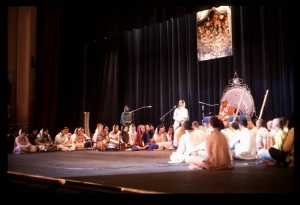CC Madhya 20.151 (1975): Difference between revisions
(Vanibot #0027: CCMirror - Mirror CC's 1996 edition to form a basis for 1975) |
(Vanibot #0020: VersionCompareLinker - added a link to the Version Compare feature) |
||
| Line 2: | Line 2: | ||
<div style="float:left">'''[[Sri Caitanya-caritamrta (1975)|Śrī Caitanya-caritāmṛta (1975)]] - [[CC Madhya (1975)|Madhya-līlā]] - [[CC Madhya 20 (1975)|Chapter 20: Lord Śrī Caitanya Mahāprabhu Instructs Sanātana Gosvāmī in the Science of the Absolute Truth]]'''</div> | <div style="float:left">'''[[Sri Caitanya-caritamrta (1975)|Śrī Caitanya-caritāmṛta (1975)]] - [[CC Madhya (1975)|Madhya-līlā]] - [[CC Madhya 20 (1975)|Chapter 20: Lord Śrī Caitanya Mahāprabhu Instructs Sanātana Gosvāmī in the Science of the Absolute Truth]]'''</div> | ||
<div style="float:right">[[File:Go-previous.png|link=CC Madhya 20.150 (1975)|Madhya-līlā 20.150]] '''[[CC Madhya 20.150 (1975)|Madhya-līlā 20.150]] - [[CC Madhya 20.152 (1975)|Madhya-līlā 20.152]]''' [[File:Go-next.png|link=CC Madhya 20.152 (1975)|Madhya-līlā 20.152]]</div> | <div style="float:right">[[File:Go-previous.png|link=CC Madhya 20.150 (1975)|Madhya-līlā 20.150]] '''[[CC Madhya 20.150 (1975)|Madhya-līlā 20.150]] - [[CC Madhya 20.152 (1975)|Madhya-līlā 20.152]]''' [[File:Go-next.png|link=CC Madhya 20.152 (1975)|Madhya-līlā 20.152]]</div> | ||
{{CompareVersions|CC|Madhya 20.151|CC 1975|CC 1996}} | |||
{{RandomImage}} | {{RandomImage}} | ||
==== TEXT 151 ==== | ==== TEXT 151 ==== | ||
| Line 27: | Line 26: | ||
<div class="translation"> | <div class="translation"> | ||
" 'The Tenth Canto of Śrīmad-Bhāgavatam reveals the tenth object, the Supreme Personality of Godhead, who is the shelter of all surrendered souls. He is known as Śrī Kṛṣṇa, and He is the ultimate source of all the universes. Let me offer my obeisances unto Him.' | |||
</div> | </div> | ||
| Line 34: | Line 33: | ||
<div class="purport"> | <div class="purport"> | ||
This is a quotation from | This is a quotation from Bhāvārtha-dīpikā, Śrīdhara Svāmī's commentary on Śrīmad-Bhāgavatam ([[SB 10.1.1|10.1.1]]). In the Tenth Canto of Śrīmad-Bhāgavatam there is a description of the āśraya-tattva, Śrī Kṛṣṇa. There are two tattvas-āśraya-tattva and āśrita-tattva. Āśraya-tattva is the objective, and āśrita-tattva is the subjective. Since the lotus feet of Lord Śrī Kṛṣṇa are the shelter of all devotees, Śrī Kṛṣṇa is called paraṁ dhāma. In Bhagavad-gītā it is stated: paraṁ brahma paraṁ dhāma pavitraṁ paramaṁ bhavān. Everything is resting under the lotus feet of Kṛṣṇa. In Śrīmad-Bhāgavatam ([[SB 10.14.58|10.14.58]]) it is stated: | ||
:samāśritā ye pada-pallava-plavaṁ | :samāśritā ye pada-pallava-plavaṁ | ||
:mahat-padaṁ puṇya-yaśo murāreḥ | :mahat-padaṁ puṇya-yaśo-murāreḥ | ||
Under the lotus feet of Śrī Kṛṣṇa, the entire mahat-tattva is existing. Since everything is under Śrī | Under the lotus feet of Śrī Kṛṣṇa, the entire mahat-tattva is existing. Since everything is under Śrī Kṛṣṇa's protection, Śrī Kṛṣṇa is called āśraya-tattva. Everything else is called āśrita-tattva. The material creation is also called āśrita-tattva. Liberation from material bondage and the attainment of the spiritual platform are also āśrita-tattva. Kṛṣṇa is the only āśraya-tattva. In the beginning of the creation there are Mahā-Viṣṇu, Garbhodakaśāyī Viṣṇu and Kṣīrodakaśāyī Viṣṇu. They are also āśraya-tattva. Kṛṣṇa is the cause of all causes (sarva-kāraṇa-kāraṇam). To understand Kṛṣṇa perfectly, one has to make an analytical study of āśraya-tattva and āśrita-tattva. | ||
</div> | </div> | ||
Latest revision as of 12:44, 27 January 2020

A.C. Bhaktivedanta Swami Prabhupada
TEXT 151
- daśame daśamaṁ lakṣyam
- āśritāśraya-vigraham
- śrī-kṛṣṇākhyaṁ paraṁ dhāma
- jagad-dhāma namāmi tat
SYNONYMS
daśame—in the Tenth Canto; daśamam—the tenth subject matter; lakṣyam—to be seen; āśrita—of the sheltered; āśraya—of the shelter; vigraham—who is the form; śrī-kṛṣṇa-ākhyam—known as Lord Śrī Kṛṣṇa; param—supreme; dhāma—abode; jagat-dhāma—the abode of the universes; namāmi—I offer my obeisances; tat—to Him.
TRANSLATION
" 'The Tenth Canto of Śrīmad-Bhāgavatam reveals the tenth object, the Supreme Personality of Godhead, who is the shelter of all surrendered souls. He is known as Śrī Kṛṣṇa, and He is the ultimate source of all the universes. Let me offer my obeisances unto Him.'
PURPORT
This is a quotation from Bhāvārtha-dīpikā, Śrīdhara Svāmī's commentary on Śrīmad-Bhāgavatam (10.1.1). In the Tenth Canto of Śrīmad-Bhāgavatam there is a description of the āśraya-tattva, Śrī Kṛṣṇa. There are two tattvas-āśraya-tattva and āśrita-tattva. Āśraya-tattva is the objective, and āśrita-tattva is the subjective. Since the lotus feet of Lord Śrī Kṛṣṇa are the shelter of all devotees, Śrī Kṛṣṇa is called paraṁ dhāma. In Bhagavad-gītā it is stated: paraṁ brahma paraṁ dhāma pavitraṁ paramaṁ bhavān. Everything is resting under the lotus feet of Kṛṣṇa. In Śrīmad-Bhāgavatam (10.14.58) it is stated:
- samāśritā ye pada-pallava-plavaṁ
- mahat-padaṁ puṇya-yaśo-murāreḥ
Under the lotus feet of Śrī Kṛṣṇa, the entire mahat-tattva is existing. Since everything is under Śrī Kṛṣṇa's protection, Śrī Kṛṣṇa is called āśraya-tattva. Everything else is called āśrita-tattva. The material creation is also called āśrita-tattva. Liberation from material bondage and the attainment of the spiritual platform are also āśrita-tattva. Kṛṣṇa is the only āśraya-tattva. In the beginning of the creation there are Mahā-Viṣṇu, Garbhodakaśāyī Viṣṇu and Kṣīrodakaśāyī Viṣṇu. They are also āśraya-tattva. Kṛṣṇa is the cause of all causes (sarva-kāraṇa-kāraṇam). To understand Kṛṣṇa perfectly, one has to make an analytical study of āśraya-tattva and āśrita-tattva.